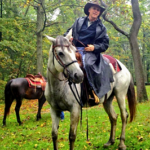
I’ve been avoiding my photo box, because of the potent memories in it. The box was more than a container for Kodak packages– it contained the history of my little white mare who, after 29 years with me, was euthanized last June. This morning, though, I saw the first brave little white rose of spring on the bush in our pasture, and I knew I was ready to look in the box.
If a picture’s worth a thousand words, then the cardboard box held uncountable syllables and a million memories. There was the sale brochure with Rana’s purchase price– $725– written in my 12 year–old pencil scrawl. The photos of Rana as a yearling and young mare show a dark gray mare with white stockings and a wide blaze, and, always, those wise eyes. I wrote about Rana’s Eyes last year (click here) and received many beautiful letters from horse owners touched by the story of my oldest friend. I put the box in order today, and I’m finally ready to write about her again.
Rana was undeniably common to look at, small–even scrawny–and few who saw her in her dotage in our backyard would have known she once was a show horse. Her hair grew like a yak, her coat was as much yellow as white, and her arthritic knees bowed out like Charlie Chaplin’s little tramp. The last photos I have of Rana show her with four giggling neighbor girls perched on her bony back like birds on a wire. Horse and riders look delighted.
Rana was a show horse in her youth, and because we did a low impact event, her last show–and championship–was the Scottsdale Arabian show when she was 24. She always hated the rail classes but with her brain power and compact size, Rana excelled in trail classes. From local events to the U.S. and Canadian Nationals, the little white mare won a lot. I have an entire snapshot album of win photos.
She spoiled me by being a very low maintenance (no shoes, no schooling, lame one day in thirty years) with a very high rate of ribbon return. I once calculated that Rana was first, champion, or reserve champion more that 73 percent of the time. Had she been a racehorse, I owned Man O’ War.
‘Owning Rana’ was a relative term. I was her caregiver, and she allowed me to ride her. Even approaching thirty years old, she was as aloof as a silent-screen star; haughty as a princess, except with children. As her minion, I always knew the final kindness of ending her life would fall to me and, like a trusted servant, I hoped I’d be up to the task and know when it was time to ease her transition to the next world.
I awoke one night last June to that nightmarish sound that makes all horsemen spring from bed: a horse was cast. The repeated clanging of hoofs again a wall meant someone was in trouble. In a minute I was out at the barn, but I knew during that sixty-second dash that it had to be Rana scrambling. She’d needed help up the day before when she lay down to rest, her arthritic knees no longer able to lift her now-frail little white body. There she lay in the dark, struggling frantically, caked with sweat and manure, and terrified. I had seen almost every emotion that a horse’s eyes could convey in Rana’s eyes, but never, ever, fear before that night.
We put longe lines around her feet and rolled her away from the wall, then helped her heave up to her quivering legs. It was a warm summer night but Rana was drenched with sweat, her sides bellowing to gulp air as she hyperventilated. I stayed with her some time, afraid to look at her because I didn’t think I could keep breathing if I cried any harder. Gradually, Rana calmed, then turned to finish her hay, and I walked back to the house knowing that my last responsibility as her caregiver was at hand. It was time.
My husband and I had previously scheduled a short overnight trip leaving the next day, so I asked two special horse friends if they could help Rana on her way to wherever the wonderful animals go. After phone calls to the veterinarian, the dead stock removal people, and the pet cemetery that next morning, I hugged her shaggy neck, looked into her deep honeyed eyes for the last time, and drove away.
Karen and Yvette gave her a bath and combed out her beautiful silver tail then braided it with a pink ribbon. My friends said she went easy, perhaps aware that her sore knees and back and her nubbins of teeth would no longer hurt her. Out on her little lawn, Rana gave the vet a wary, warning snort as the first needle entered her vein, then simply stood while the second shot stopped her heart. She slowly dropped to the grass, as if planning a nice roll, and lay there.
The grim green truck took her little white body away, but not, after all these years, to the rendering plant. Rana was cremated, and her ashes now nourish a small, brave, thorny white rose that grows in the sun near her pasture. The rose is like Rana, and the rose is called Peace.
© 2003 Suzanne Drnec
Writing or riding, Suzanne Drnec enjoys horses and their people. Drnec is president of Hobby Horse Clothing Company, a show apparel manufacturer, and also the caretaker of an assortment of lawn ornaments, currently three Paints. Comments? E–mail them to suzi@hobbyhorseinc.com.







